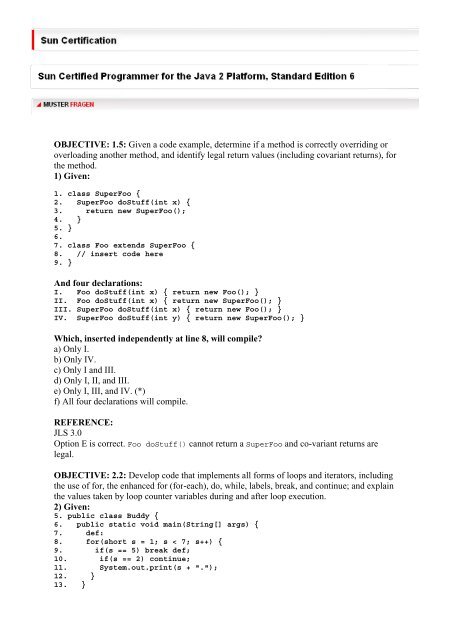Musterfragen SCJP Ed.6 - AS-SYSTEME
Musterfragen SCJP Ed.6 - AS-SYSTEME
Musterfragen SCJP Ed.6 - AS-SYSTEME
Create successful ePaper yourself
Turn your PDF publications into a flip-book with our unique Google optimized e-Paper software.
OBJECCTIVE:<br />
1.55:<br />
Given a code<br />
examplle,<br />
determin ne if a methood<br />
is correcctly<br />
overridi ing or<br />
overloadding<br />
anotheer<br />
method, aand<br />
identifyy<br />
legal return n values (inncluding<br />
covvariant<br />
retur rns), for<br />
the methhod.<br />
1) Giveen:<br />
1. class<br />
SuperFoo<br />
{<br />
2. SuuperFoo<br />
doStuff(int<br />
x) {<br />
3. return neew<br />
SuperFoo();<br />
4. }<br />
5. }<br />
6.<br />
7. class<br />
Foo extends<br />
SuperFoo<br />
{<br />
8. / / insert code here<br />
9. }<br />
And fouur<br />
declarattions:<br />
I. Fooo<br />
doStuff(int<br />
x) { return new Foo() ; }<br />
II. Fooo<br />
doStuff(int<br />
x) { return new Super rFoo(); }<br />
III. SuuperFoo<br />
doStuff(int<br />
x) { return<br />
new Foo(); }<br />
IV. SuuperFoo<br />
doStuff(int<br />
y) { return<br />
new SuperFoo( ); }<br />
Which, , inserted inndependenttly<br />
at line 88,<br />
will comp pile?<br />
a) Only I.<br />
b) Onlyy<br />
IV.<br />
c) Only I and III.<br />
d) Onlyy<br />
I, II, and IIII.<br />
e) Only I, III, and IIV.<br />
(*)<br />
f) All foour<br />
declarations<br />
will coompile.<br />
REFERRENCE:<br />
JLS 3.0<br />
Option E is correctt.<br />
Foo doSttuff()<br />
cannnot<br />
return a SuperFoo aand<br />
co-variaant<br />
returns are a<br />
legal.<br />
OBJECCTIVE:<br />
2.22:<br />
Develop ccode<br />
that immplements<br />
all a forms of loops and iterators,<br />
inc cluding<br />
the use of for, the eenhanced<br />
foor<br />
(for-each) ), do, while,<br />
labels, breeak,<br />
and conntinue;<br />
and explain<br />
e<br />
the valuues<br />
taken byy<br />
loop countter<br />
variables<br />
during and d after loopp<br />
execution.<br />
2) Giveen:<br />
5. public<br />
class Buddy {<br />
6. puublic<br />
static<br />
void mmain(String[]<br />
args)<br />
{<br />
7. def:<br />
8. for(short<br />
s = 1; s < 7; s+ +) {<br />
9. if(s == = 5) break<br />
def;<br />
10. if(s = == 2) continue;<br />
11. Systemm.out.print(s<br />
+ ". ");<br />
12. }<br />
13. }
14. }<br />
What is the result?<br />
a) 1.<br />
b) 1.2.<br />
c) 1.3.4. (*)<br />
d) 1.2.3.4.<br />
e) 1.3.4.5.6.<br />
f) 1.2.3.4.5.6.<br />
g) Compilation fails.<br />
REFERENCE:<br />
JLS 3.0<br />
Option C is correct. The continue skips the current iteration, the break ends the entire loop.<br />
OBJECTIVE: 2.5: Recognize the effect of an exception arising at a specified point in a code<br />
fragment. Note that the exception may be a runtime exception, a checked exception, or an<br />
error.<br />
3) Given:<br />
1. class Birds {<br />
2. public static void main(String [] args) {<br />
3. try {<br />
4. throw new Exception();<br />
5. } catch (Exception e) {<br />
6. try {<br />
7. throw new Exception();<br />
8. } catch (Exception e2) { System.out.print("inner "); }<br />
9. System.out.print("middle ");<br />
10. }<br />
11. System.out.print("outer ");<br />
12. }<br />
13. }<br />
What is the result?<br />
a) inner<br />
b) inner outer<br />
c) middle outer<br />
d) inner middle outer (*)<br />
e) middle inner outer<br />
f) Compilation fails.<br />
g) An exception is thrown at runtime.<br />
REFERENCE:<br />
JLS 3.0<br />
Option D is correct. It is legal to nest try/catches and normal flow rules apply.<br />
OBJECTIVE: 3.3: Develop code that serializes and/or de-serializes objects using the<br />
following APIs from java.io: DataInputStream, DataOutputStream, FileInputStream,<br />
FileOutputStream, ObjectInputStream, ObjectOutputStream, and Serializable.<br />
4) Given:<br />
2. import java.io.*;<br />
3. public class Network {<br />
4. public static void main(String[] args) {<br />
5. Traveler t = new Traveler();
6. t.x1 = 7; t.x2 = 7; t.x3 = 7;<br />
7. // serialize t then deserialize t<br />
8. System.out.println(t.x1 + " " + t.x2 + " " + t.x3);<br />
9. }<br />
10. }<br />
11. class Traveler implements Serializable {<br />
12. static int x1 = 0;<br />
13. volatile int x2 = 0;<br />
14. transient int x3 = 0;<br />
15. }<br />
If, on line 7, t is successfully serialized and then deserialized, what is the result?<br />
a) 0 0 0<br />
b) 0 7 0 (*)<br />
c) 0 7 7<br />
d) 7 0 0<br />
e) 7 7 0<br />
f) 7 7 7<br />
REFERENCE:<br />
API<br />
Option B is correct. Because static variables belong to the class and not to instances of a class,<br />
they are not serialized.<br />
OBJECTIVE: 3.5: Write code that uses standard J2SE APIs in the java.util and<br />
java.util.regex packages to format or parse strings or streams. For strings, write code that uses<br />
the Pattern and Matcher classes and the String.split method. Recognize and use regular<br />
expression patterns for matching (limited to: .(dot), *(star), +(plus), ?, \d, \s, \w, [], ()) The use<br />
of *, +, and ? will be limited to greedy quantifiers, and the parenthesis operator will only be<br />
used as a grouping mechanism, not for capturing content during matching. For streams, write<br />
code using the Formatter and Scanner classes and the PrintWriter.format/printf methods.<br />
Recognize and use formatting parameters (limited to: %b, %c, %d, %f, %s) in format strings.<br />
5) Which regex pattern finds both 0x4A and 0X5 from within a source file?<br />
a) 0[xX][a-fA-F0-9]<br />
b) 0[xX](a-fA-F0-9)<br />
c) 0[xX]([a-fA-F0-9])<br />
d) 0[xX]([a-fA-F0-9])+ (*)<br />
e) 0[xX]([a-fA-F0-9])?<br />
REFERENCE:<br />
API,<br />
Option D is correct. The + quantifier finds 1 or more occurrences of hex characters after an 0x<br />
is found.<br />
OBJECTIVE: 4.3: Given a scenario, write code that makes appropriate use of object locking<br />
to protect static or instance variables from concurrent access problems.<br />
6) Given:<br />
5. public class Lockdown implements Runnable {<br />
6. public static void main(String[] args) {<br />
7. new Thread(new Lockdown())start();<br />
8. new Thread(new Lockdown())start();<br />
9. }<br />
10. public void run() { locked(Thread.currentThread()getId()); }<br />
11. synchronized void locked(long id) {
12. System.out.print(id + "a ");<br />
13. System.out.print(id + "b ");<br />
14. }<br />
15. }<br />
What is true about possible sets of output from this code?<br />
a) Set 6a 7a 7b 8a and set 7a 7b 8a 8b are both possible.<br />
b) Set 7a 7b 8a 8b and set 6a 7a 6b 7b are both possible. (*)<br />
c) It could be set 7a 7b 8a 8b but set 6a 7a 6b 7b is NOT possible.<br />
d) It could be set 7a 8a 7b 8b but set 6a 6b 7a 7b is NOT possible.<br />
REFERENCE:<br />
JLS 3.0<br />
Option B is correct. Two different Lockdown objects are using the locked() method.<br />
OBJECTIVE: 5.5: Develop code that implements "is-a" and/or "has-a" relationships.<br />
7) A programmer wants to develop an application in which Fizzlers are a kind of<br />
Whoosh, and Fizzlers also fulfill the contract of Oompahs. In addition, Whooshes are<br />
composed with several Wingits.<br />
Which code represents this design?<br />
a) class Wingit { }<br />
class Fizzler extends Oompah implements Whoosh { }<br />
interface Whoosh {<br />
Wingits [] w;<br />
}<br />
class Oompah { }<br />
b) class Wingit { }<br />
class Fizzler extends Whoosh implements Oompah { }<br />
class Whoosh {<br />
Wingits [] w;<br />
}<br />
interface Oompah { } (*)<br />
c) class Fizzler { }<br />
class Wingit extends Fizzler implements Oompah { }<br />
class Whoosh {<br />
Wingits [] w;<br />
}<br />
interface Oompah { }<br />
d) interface Wingit { }<br />
class Fizzler extends Whoosh implements Wingit { }<br />
class Wingit {<br />
Whoosh [] w;<br />
}<br />
class Whoosh { }<br />
REFERENCE:<br />
Sun's Java course OO226<br />
Option B is correct. 'Kind of' translates to extends, 'contract' translates to implements, and<br />
'composed' translates to a has-a implementation.<br />
OBJECTIVE: 6.3: Write code that uses the generic versions of the Collections API, in<br />
particular, the Set, List, and Map interfaces and implementation classes. Recognize the<br />
limitations of the non-generic Collections API and how to refactor code to use the generic<br />
versions. Write code that uses the NavigableSet and NavigableMap interfaces.
8) Given:<br />
4. import java.util.*;<br />
5. public class Quest {<br />
6. public static void main(String[] args) {<br />
7. TreeMap<String, Integer> myMap = new TreeMap<String,<br />
Integer>();<br />
8. myMap.put("ak", 50); myMap.put("co", 60);<br />
9. myMap.put("ca", 70); myMap.put("ar", 80);<br />
10. NavigableMap<String, Integer> myMap2 = myMap.headMap("d",<br />
true);<br />
11. myMap.put("fl", 90);<br />
12. myMap2.put("hi", 100);<br />
13. System.out.println(myMap.size() + " " + myMap2.size());<br />
14. }<br />
15. }<br />
What is the result?<br />
a) 4 4<br />
b) 5 4<br />
c) 5 5<br />
d) 6 5<br />
e) 6 6<br />
f) Compilation fails.<br />
g) An exception is thrown at runtime. (*)<br />
REFERENCE:<br />
API<br />
Answer: G is correct. Line 12 causes a "key out of range" exception.<br />
OBJECTIVE: 6.5: Use capabilities in the java.util package to write code to manipulate a list<br />
by sorting, performing a binary search, or converting the list to an array. Use capabilities in<br />
the java.util package to write code to manipulate an array by sorting, performing a binary<br />
search, or converting the array to a list. Use the java.util.Comparator and<br />
java.lang.Comparable interfaces to affect the sorting of lists and arrays. Furthermore,<br />
recognize the effect of the "natural ordering" of primitive wrapper classes and java.lang.String<br />
on sorting.<br />
9) Given:<br />
3. import java.util.*;<br />
4. public class ToDo {<br />
5. public static void main(String[] args) {<br />
6. String[] dogs = {"fido", "clover", "gus", "aiko"};<br />
7. List dogList = Arrays.asList(dogs);<br />
8. dogList.add("spot");<br />
9. dogs[0] = "fluffy";<br />
10. System.out.println(dogList);<br />
11. for(String s: dogs) System.out.print(s + " ");<br />
12. }<br />
13. }<br />
What is the result?<br />
a) [fluffy, clover, gus, aiko]<br />
fluffy, clover, gus, aiko,<br />
b) [fluffy, clover, gus, aiko]<br />
fluffy, clover, gus, aiko, spot,<br />
c) [fluffy, clover, gus, aiko, spot]<br />
fluffy, clover, gus, aiko,
d) [fluffy, clover, gus, aiko, spot]<br />
fluffy, clover, gus, aiko, spot,<br />
e) Compilation fails.<br />
f) An exception is thrown at runtime. (*)<br />
REFERENCE:<br />
API<br />
Option F is correct. The asList() method creates a fixed-size list that is backed by the array,<br />
so no additions are possible.<br />
OBJECTIVE: 7.2: Given an example of a class and a command-line, determine the expected<br />
runtime behavior.<br />
10) Given:<br />
1. class x {<br />
2. public static void main(String [] args) {<br />
3. String p = System.getProperty("x");<br />
4. if(p.equals(args[1]))<br />
5. System.out.println("found");<br />
6. }<br />
7. }<br />
Which command-line invocation will produce the output found?<br />
a) java -Dx=y x y z<br />
b) java -Px=y x y z<br />
c) java -Dx=y x x y z (*)<br />
d) java -Px=y x x y z<br />
e) java x x y z -Dx=y<br />
f) java x x y z -Px=y<br />
REFERENCE:<br />
API for java command<br />
Option C is correct. -D sets a property and args[1] is the second argument (whose value is y)















